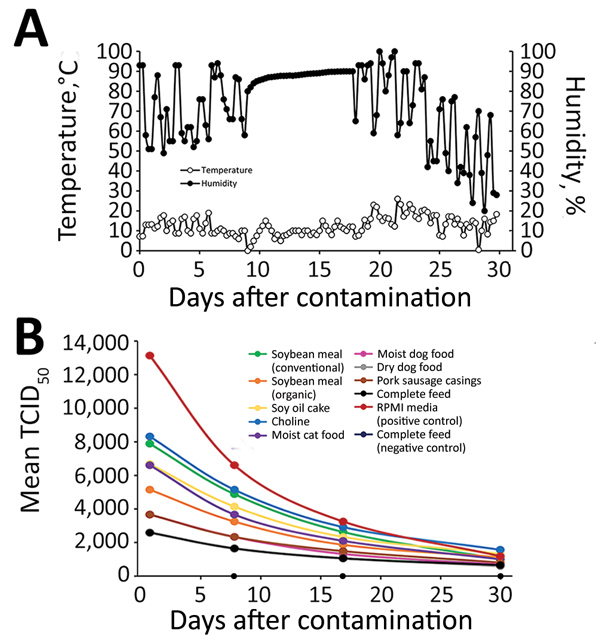Volume 25, Number 12—December 2019
Dispatch
Half-Life of African Swine Fever Virus in Shipped Feed
Figure

Figure. Decay of African swine fever virus (ASFV) Georgia 2007 in feed ingredients exposed to temperature and humidity conditions simulating a 30-day trans-Atlantic shipment. A) Temperature and humidity conditions, which fluctuated every 6 hours during the course of the 30-day environmental model. Environmental conditions were based on the availability of historical data logged from April 5, 2011, through May 4, 2011 (5,11) to model trans-Atlantic shipment from Warsaw, Poland, to Des Moines, Iowa, USA. B) Mean TCID50 of ASFV Georgia 2007 quantified on porcine alveolar macrophages at 1, 8, 17, and 30 days after contamination for different types of feed and controls. Feed ingredients were inoculated with 105 TCID50 ASFV based on previous half-life calculations (5,10) and the infectious dose in feed (6). TCID50, 50% tissue culture infective dose.
References
- Forth JH, Tignon M, Cay AB, Forth LF, Höper D, Blome S, et al. Comparative analysis of whole-genome sequence of African swine fever virus Belgium 2018/1. Emerg Infect Dis. 2019;25:1249–52. DOIPubMedGoogle Scholar
- Le VP, Jeong DG, Yoon SW, Kwon HM, Trinh TBN, Nguyen TL, et al. Outbreak of African swine fever, Vietnam, 2019. Emerg Infect Dis. 2019;25:1433–5. DOIPubMedGoogle Scholar
- Zhou X, Li N, Luo Y, Liu Y, Miao F, Chen T, et al. Emergence of African swine fever in China, 2018. Transbound Emerg Dis. 2018;65:1482–4. DOIPubMedGoogle Scholar
- Niederwerder MC, Hesse RA. Swine enteric coronavirus disease: A review of 4 years with porcine epidemic diarrhoea virus and porcine deltacoronavirus in the United States and Canada. Transbound Emerg Dis. 2018;65:660–75. DOIPubMedGoogle Scholar
- Dee SA, Bauermann FV, Niederwerder MC, Singrey A, Clement T, de Lima M, et al. Survival of viral pathogens in animal feed ingredients under transboundary shipping models. PLoS One. 2018;13:
e0194509 . DOIPubMedGoogle Scholar - Niederwerder MC, Stoian AMM, Rowland RRR, Dritz SS, Petrovan V, Constance LA, et al. Infectious dose of African swine fever virus when consumed naturally in liquid or feed. Emerg Infect Dis. 2019;25:891–7. DOIPubMedGoogle Scholar
- Zhai SL, Wei WK, Sun MF, Lv DH, Xu ZH. African swine fever spread in China. Vet Rec. 2019;184:559. DOIPubMedGoogle Scholar
- Oļševskis E, Guberti V, Seržants M, Westergaard J, Gallardo C, Rodze I, et al. African swine fever virus introduction into the EU in 2014: Experience of Latvia. Res Vet Sci. 2016;105:28–30. DOIPubMedGoogle Scholar
- Wen X, He X, Zhang X, Zhang X, Liu L, Guan Y, et al. Genome sequences derived from pig and dried blood pig feed samples provide important insights into the transmission of African swine fever virus in China in 2018. Emerg Microbes Infect. 2019;8:303–6. DOIPubMedGoogle Scholar
- Dee SA, Bauermann FV, Niederwerder MC, Singrey A, Clement T, de Lima M, et al. Correction: Survival of viral pathogens in animal feed ingredients under transboundary shipping models. PLoS One. 2019;14:
e0214529 . DOIPubMedGoogle Scholar - Dee SA, Bauermann FV, Niederwerder MC, Singrey A, Clement T, de Lima M, et al. Correction: Survival of viral pathogens in animal feed ingredients under transboundary shipping models. PLoS One. 2018;13:
e0208130 . DOIPubMedGoogle Scholar - Rowlands RJ, Michaud V, Heath L, Hutchings G, Oura C, Vosloo W, et al. African swine fever virus isolate, Georgia, 2007. Emerg Infect Dis. 2008;14:1870–4. DOIPubMedGoogle Scholar
- Finney DJ. The Spearman-Karber method. In: Finney DJ, editor. Statistical method in biological assay. 2nd ed. London: Charles Griffin; 1964. p. 524–30.
- Bryan M, Zimmerman JJ, Berry WJ. The use of half-lives and associated confidence intervals in biological research. Vet Res Commun. 1990;14:235–40. DOIPubMedGoogle Scholar
- Niederwerder MC, Rowland RR. Is there a risk for introducing porcine reproductive and respiratory syndrome virus (PRRSV) through the legal importation of pork? Food Environ Virol. 2017;9:1–13. DOIPubMedGoogle Scholar